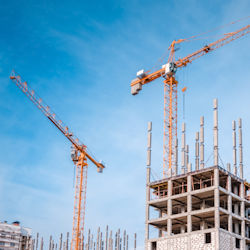Tower Cranes and Derricks
Tower Cranes
Tower cranes present unique safety issues that are addressed in OSHA 1926.1435.
Erecting, Climbing, and Dismantling
To reflect industry terminology, "erecting, climbing, and dismantling" are used instead of "assembly/disassembly" when referring to tower cranes. The following requirements apply in addition to those specified in OSHA 1926.1403-1406:
- Tower crane foundations and structural supports (including both the portions of the structure used for support and the means of attachment) must be designed by the manufacturer or a registered professional engineer.
- The Assembly/Disassembly (A/D) director must determine that tower crane foundations and structural supports are installed in accord with their design.
- The A/D Director must address the backward stability of self-erecting cranes or cranes on traveling or static undercarriages.
- Wind must not exceed the speed recommended by the manufacturer or, where the manufacturer does not specify this information, the speed determined by a qualified person.
- Towers must be erected plumb to the manufacturer's tolerance and verified by a qualified person. Where the manufacturer does not specify plumb tolerance, the crane tower must be plumb to a tolerance of at least 1:500 (approximately 1 inch in 40 feet).
- On jobsites where more than one fixed jib (hammerhead) tower crane is installed, the cranes must be located such that no crane can come in contact with the structure of another crane. Cranes are permitted to pass over one another.
- Prior to, and during, all climbing procedures (including inside climbing and top climbing), the employer must comply with all manufacturer prohibitions and have a registered professional engineer verify that the host structure is strong enough to sustain the forces imposed through the braces, brace anchorages, and supporting floors.
- Equipment must not be erected, dismantled or operated without the amount and position of counterweight and/or ballast in place as specified by the manufacturer or a registered professional engineer familiar with the equipment. The maximum counterweight and/or ballast specified by the manufacturer or registered professional engineer must not be exceeded.
- The size and location of signs installed on tower cranes must be in accord with manufacturer specifications. Where these are unavailable, a registered professional engineer familiar with the type of equipment involved must approve in writing the size and location of any signs.
Knowledge Check Choose the best answer for the question.
7-1. Tower crane foundations and structural supports must be designed by the manufacturer or a(n) _____.
You forgot to answer the question!

